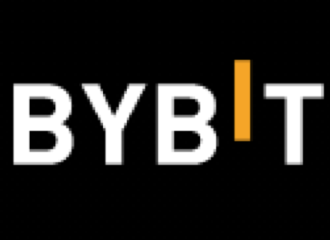At the heart of the Arbitrum network lies ARB, its native cryptocurrency, which powers the network’s security and decision-making processes. If you are optimistic about the project’s potential and plan to buy Arbitrum as a strategic investment, this guide will show you how to do so.
KEY TAKEAWAYS
➤ Arbitrum is a layer-2 scaling solution for Ethereum that enhances transaction throughput and reduces fees by processing transactions off-chain.
➤ ARB, the native cryptocurrency of the Arbitrum network, functions primarily as a governance token and does not pay transaction fees but plays a crucial role in governance.
➤ Arbitrum offers high compatibility with Ethereum’s EVM, making it easier for developers to deploy existing Ethereum applications with minimal changes.
➤ Before investing in ARB, it’s important to consider the cryptocurrency’s volatility and market position, as well as understand the potential risks and rewards associated with its future development.
How to buy Arbitrum (ARB)
Buying Arbitrum (ARB) is simple and straightforward. Simply do the following:
- Sign-up on an exchange.
- Verify your identity.
- Buy Arbitrum.
For demonstration, we will be using Bybit, thanks to its straightforward and user-friendly interface. The buying process is, by and large, the same for most exchanges, albeit with some minor variations here and there.
Step 1: Sign-up
If you don’t already have an account on Bybit, it’s time to create one. The process is as simple as it gets. You can sign-up using your email or mobile number, or you can log in directly using your Google or Apple ID.
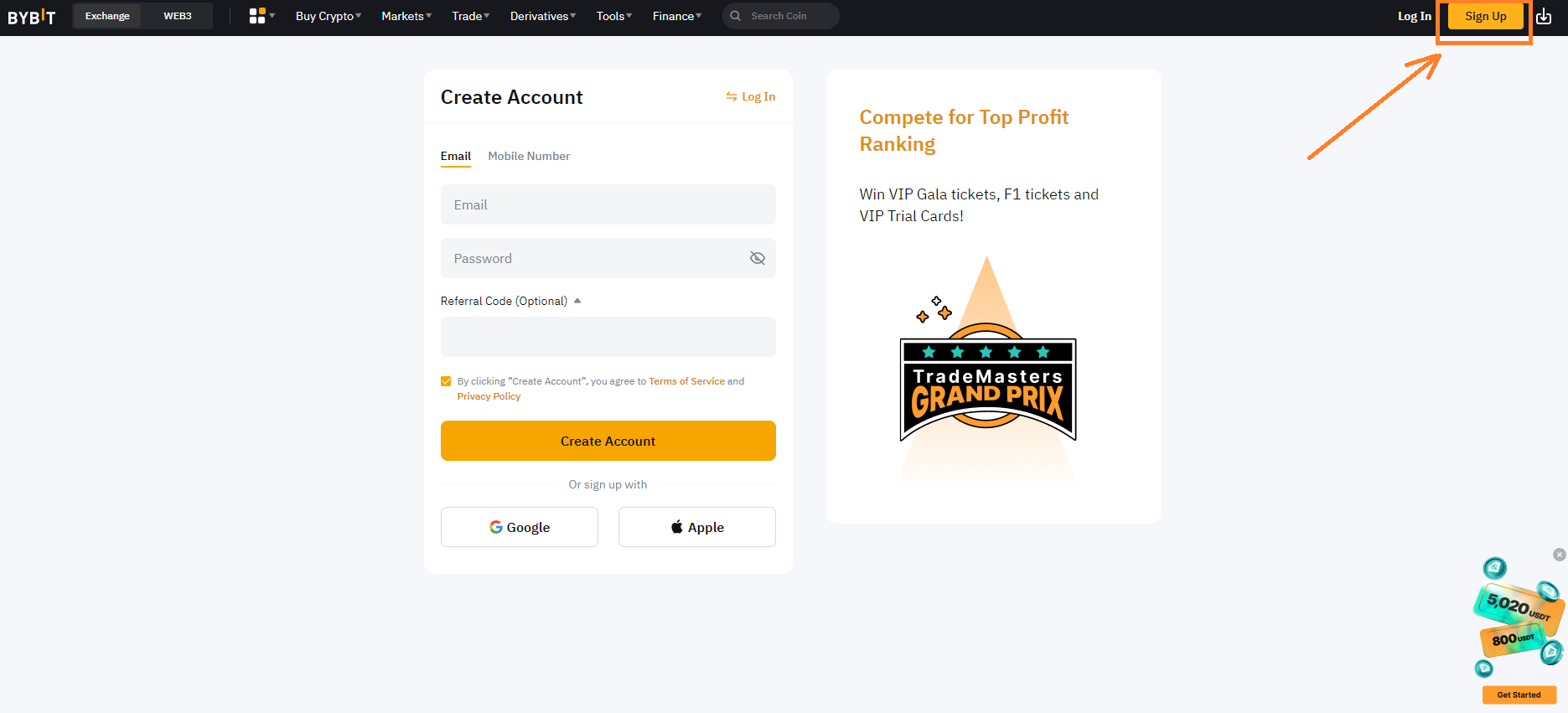
Step 2: Verify identity
Up next, you will be prompted to verify identity. You must undergo this mandatory KYC process before being able to deposit, buy, or trade. Level-1 verification requires you to submit a government-issued ID (such as passport, driver’s license, etc.) and appear on live camera for liveness check. Generally, the process doesn’t take more than 15 minutes, although you may have to wait longer in some cases.
Sponsored
Step 3: Buy ARB
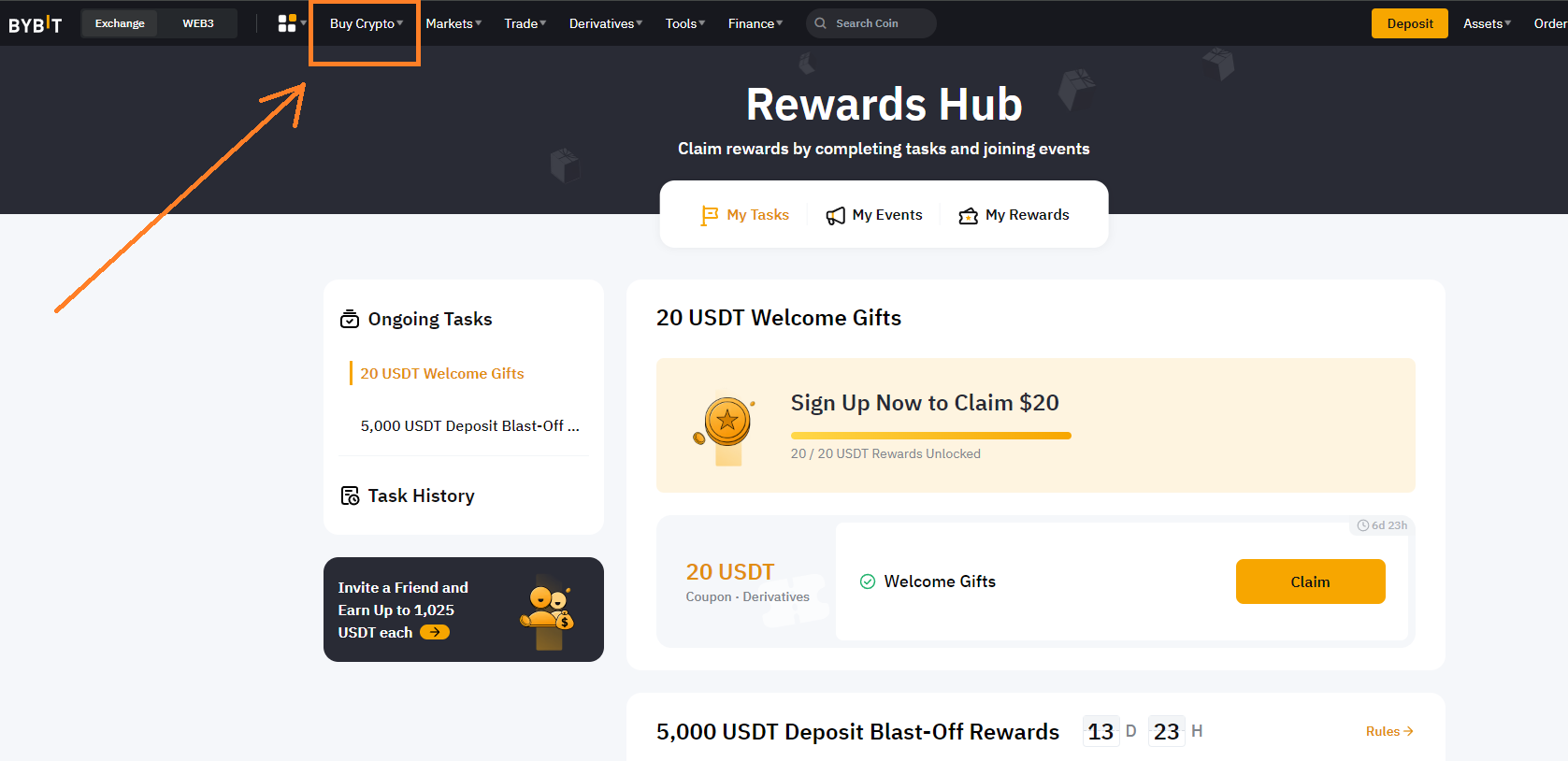
Select your preferred fiat currency in the “Spend” field and choose Arbitrum (ARB) in the “Receive” field. Bybit accepts a range of fiat deposits including USD, AUD, EUR, INR, RUB, MXN, HKD, IDR, and many more.
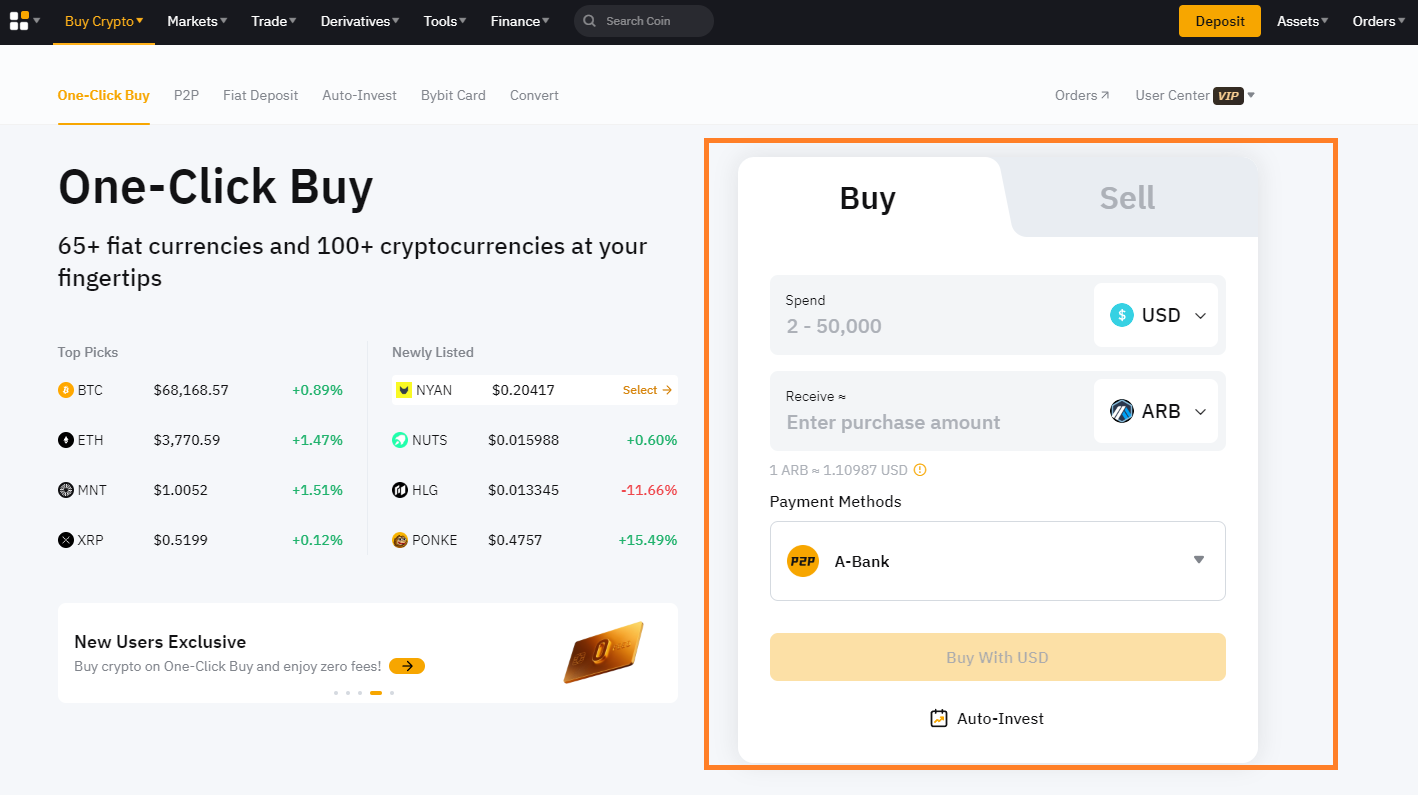

Where to buy Arbitrum (ARB)
IF you decide to buy Arbitrum, it’s important to select a compatible crypto exchange. Here are a few of the top options to choose from in 2025.
1. OKX
In our assessment, OKX emerged as a top contender primarily due to its ability to serve new and experienced users equally well. It has a wide range of trading pairs to choose from and the liquidity for major assets is generally on the higher side. Additionally, the exchange also has a decent track record in terms of security.
- High liquidity
- Competitive fees
- A wide range of trading pairs to choose from
- Margin and leveraged trading for advance users
- Automated trading bots
- Limited fiat support
- Doesn't offer as many educational resources in comparison to say, Coinbase
2. Coinbase
Coinbase made it to our list of top exchanges to buy ARB because of its user-friendly interface, stringent security, and a wide collection of educational resources to help out beginners. In addition to standard security features such as 2FA and sophisticated encryption, the platform also offers FDIC-insured USD balance and insured digital assets. Being one of the top exchanges in the world, it also offers some of the highest liquidity across assets.
- Intuitive interface designed for those new to cryptocurrency.
- Stringent security measures and insured USD balances
- Wide variety of cryptocurrencies available, including ARB.
- Provides helpful resources for understanding ARB and the crypto market.
- Supports various payment methods for convenient purchases.
- Fees may be slightly higher compared to some other platforms.
- Is not available in some major markets due to regulatory issues
3. Bybit
Bybit does a pretty solid job of empowering active and experienced traders with its advanced features. The platform offers a comprehensive suite of trading options, such as spot, margin, and futures trading, all with competitive fees. It also facilitates easy access through various fiat deposit methods. It is also one of the easiest platforms for new users to buy and trade crypto, as demonstrated in the “how to buy” section below.
- Spot, margin, and futures contracts cater to various trading strategies.
- Offers competitive trading fees.
- Accepts multiple fiat currencies for convenient deposits.
- Provides access to leveraged tokens and IEO participation.
- Offers 100% proof-of-reserves for verifiable asset security.
- Primarily geared towards experienced traders.
Best exchanges to buy ARB compared
Here is a quick comparison table for you to compare the next exchanges to buy Arbitrum (ARB).
| Exchange | Availability | Fees | Supported assets | Demo account |
|---|---|---|---|---|
| OKX | E.U. and 100+ countries | Up to 0.1% for trades, 0 deposit fees | BTC, ETH, ARB, DOGE, and most major coins and tokens | Yes |
| Coinbase | 100+ countries | From 0.00% to 0.40% for maker fees, and 0.05% to 0.60% for taker fees. | Nearly 400 trading pairs | No |
| Bybit | 160+ countries | Starting at 0.1% for spot trading, 0.02% for perpetual contracts | 100+ assets | Yes |
We assessed several top platforms to help you select the best crypto exchange for purchasing Arbitrum (ARB). Our evaluation was based on crucial factors such as security, fees, and user experience.
What is Arbitrum?
Arbitrum (ARB) is a cutting-edge layer-2 (L2) scaling solution for Ethereum, designed to boost the network’s performance by handling a substantial volume of transactions off-chain and only recording the final results back on-chain. Let’s break it down using an example.
Imagine Ethereum’s transaction system as a single pipe through which all transactions must pass. When too many transactions happen at once, the pipe gets clogged, slowing everything down.
This is where the role of Arbitrum kicks in. As an L2 scaling solution, Arbitrum adds additional pipes to handle the overflow. It processes a large volume of transactions in these additional pipes and only sends the final results back through the main pipe.
This smart approach reduces congestion and speeds up transactions while cutting down on gas fees. It does this by using advanced rollup technology that bundles many transactions into one neat package before processing.
How Arbitrum works under the hood
Arbitrum operates by bundling multiple transactions together and processing them off-chain on the Arbitrum chain. These transactions are compiled into rollup blocks, which are then submitted to the Ethereum main chain. This process drastically reduces the amount of data that needs to be stored on-chain. This, in turn, makes transaction processing more efficient.
Optimistic rollups
Optimistic rollups work on the assumption that all transactions are valid unless proven otherwise. After a rollup block is submitted to Ethereum, there is a challenge period during which validators can inspect the transactions. If a validator finds an incorrect transaction, they can issue a challenge. This triggers a fraud-proof mechanism to identify and correct the fraudulent transaction.
Validators are incentivized to act honestly because dishonest behavior can lead to penalties, which goes a long way in ensuring transactions are accurately verified.
Arbitrum Virtual Machine (AVM)
Arbitrum deploys its custom execution environment known as the Arbitrum Virtual Machine (AVM). The AVM executes smart contracts in a manner similar to the Ethereum Virtual Machine (EVM) — the only difference is that it operates natively on the Arbitrum chain.
This setup allows for smooth interaction between smart contracts on both the Arbitrum and Ethereum layers. It is worth mentioning here that the system’s security depends squarely on the assumption that at least one validator remains honest.
So, what happens if a validator is found to be involved in questionable activities? Well, the network has its own deterrence — validators stake tokens as collateral, which can be confiscated if they are found to be dishonest.
Sponsored SponsoredThe Nitro upgrade
The Nitro upgrade brought a significant improvement to Arbitrum’s technology. It replaced the AVM’s custom virtual machine with WebAssembly (Wasm), which enables the network to use Go code and integrate Geth, the most widely used Ethereum implementation.
This architecture allows Nitro to use Ethereum-like blocks as state checkpoints, which then improves efficiency and reduces the need for Wasm compilation only to dispute cases. Nitro’s design enables native execution of Go code, which is faster and more performant, resulting in lower fees for users.

“Nitro provides higher througput, faster finality, and more efficient dispute resolutions than previous rollups. Nitro achieves these properties through several design principles: separating secuencing of transactions from deterministic execution; combining existing Ethereum emulation software with extensions to enable cross-chain functionalities; compiling separately for execution versus proving, so that execution is fast and proving is structured and machine-independent [……]”
– Nitro whitepaper
Optimistic execution in Nitro
Nitro enhances efficiency through an innovative approach called (Optimistic)^2 execution. In this system, high-level code (Solidity, Vyper, etc.) is initially compiled to EVM bytecode, which is then transpiled to AVM instructions by ArbOS.
However, in Nitro, the node’s Go code is compiled into Wasm only when a dispute occurs. This allows the common case of native execution to be faster and more performant, while Wasm compilation is reserved for dispute resolution, optimizing the system’s overall efficiency.
Calldata compression
Arbitrum Nitro also supports calldata compression, which significantly reduces the cost of posting transaction data on Ethereum. The Nitro architecture can incorporate widely used compression libraries, ensuring efficient data handling and reducing transaction costs.
This optimization is crucial because the bulk of an Arbitrum Rollup transaction’s fee covers the cost of posting data on Ethereum. By compressing data before posting, Nitro minimizes these costs.
Closer EVM compatibility
Nitro offers closer compatibility with the Ethereum Virtual Machine (EVM) than its predecessor, the AVM. Gas units on L1 and L2 correspond 1:1. This simplifies the deployment and interaction of smart contracts. Nitro also inherits Ethereum’s node functionalities, such as transaction tracing, out-of-the-box, enhancing compatibility with existing tools and infrastructure.
Simplicity and security
Nitro’s architecture simplifies Arbitrum’s codebase by leveraging Geth’s EVM implementation. This allows ArbOS to focus on layer-2 specific functions, resulting in leaner and more accessible code. This simplicity enhances the system’s security, thus making it easier to audit and ensuring robust implementation that will only strengthen as the ecosystem grows.
To cut a long story short, Arbitrum’s innovative use of Optimistic Rollups and the Nitro upgrade now provides a scalable, efficient, and secure layer-2 solution for Ethereum.
What makes Arbitrum unique and popular
Arbitrum is not the only layer-2 crypto project tackling Ethereum’s limitations, but it is certainly one of the most popular ones. Of course, a big chunk of the credit goes to its Optimistic rollup technology, but that’s not the only factor driving its popularity. Some of the other factors are:
- Full compatibility with Ethereum: The Arbitrum Virtual Machine (AVM) is fully compatible with the Ethereum Virtual Machine (EVM). This means developers can write smart contracts for Ethereum and deploy programs written in popular languages on Arbitrum with minimal modifications. This compatibility simplifies the creation of DApps on Arbitrum, which then allows easy integration with the Ethereum mainnet.
- High throughput: Arbitrum is designed to handle high throughput and low latency transactions. This makes it ideal for various use cases such as gaming, non-fungible tokens (NFTs), and DeFi uses. Users benefit from fast transaction speeds and lower fees when using off-chain applications built on Arbitrum.
- Decentralized governance: Governance in the Arbitrum network is decentralized and powered by the ARB token. Token holders can participate in decision-making processes, and vote on proposals, fee adjustments, and other protocol changes. This ensures that the community has a say in the network’s evolution. This decentralized approach makes it an attractive option for those who want to buy Arbitrum.
What is the ARB token?
ARB is the native crypto on the Arbitrum network. It is an ERC-20 token, meaning it follows a specific set of technical standards for fungible tokens on the Ethereum blockchain. It establishes a set of rules that developers follow to create applications with their own tokens.
The ARB token is a key player in the Arbitrum network, though you can’t use it to pay for transaction fees unlike some other cryptocurrencies. Instead, ARB primarily functions as a governance token, giving holders a voice in important decisions about the network’s future — for instance, protocol updates and incentive programs.
SponsoredAdditionally, it’s used to reward validators who help secure the network. This dual role in governance and security makes ARB a potentially valuable asset for those who are invested in the Arbitrum ecosystem for the long haul.
ARB tokenomics
ARB has a circulating supply hovering just under 3 billion out of its total max supply of 10 billion. With a market cap exceeding $3.2 billion as of early June 2024, ARB is the 31st largest cryptocurrency.
The ARB token allocation is as follows:
- Investors hold a 17.53% stake in the total ARB supply.
- DAOs within the Arbitrum Ecosystem receive 1.13% of the tokens.
- Individual wallets receive a share of 11.62%.
- The DAO Treasury holds the largest portion, with 42.78%.
- The remaining 26.94% goes to the current and future team, along with advisors.
Check out our detailed Arbitrum (ARB) price prediction for a closer look at the asset’s prospects over the short, mid, and long haul.
Arbitrum (ARB) vs. other cryptocurrencies
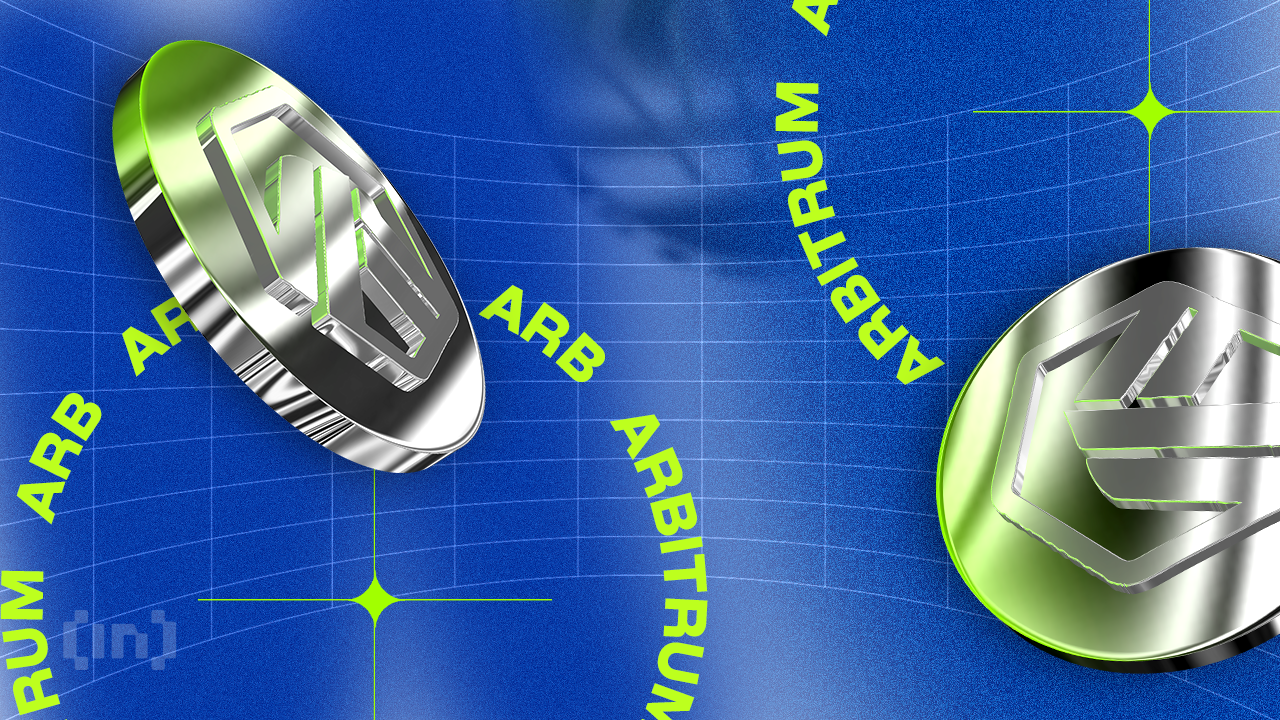
Arbitrum vs. Ethereum
Both Arbitrum and Ethereum serve distinct yet complementary roles within the blockchain ecosystem. Arbitrum is a layer-2 scaling solution that enhances Ethereum’s transaction throughput and reduces fees. In contrast, Ethereum is a foundational layer-1 blockchain that supports smart contracts and decentralized applications.
Purpose and functionality:
- Arbitrum: Designed to scale Ethereum by processing transactions off-chain and submitting rollup blocks to the Ethereum blockchain.
- Ethereum: A layer-1 platform for building and running decentralized applications.
Scalability:
- Arbitrum: Increases scalability by handling transactions off-chain, thereby significantly boosting throughput.
- Ethereum: Faces scalability challenges due to its on-chain transaction processing, which leads to higher fees and slower speeds during congestion.
Transaction speed and fees:
- Arbitrum: Offers faster transaction speeds and lower fees due to its off-chain processing.
- Ethereum: Generally slower and more expensive because all transactions are processed on-chain.
Compatibility:
- Arbitrum: Fully compatible with the Ethereum Virtual Machine (EVM), enabling seamless deployment of Ethereum smart contracts with minimal modifications.
- Ethereum: The native platform for EVM, ensuring full compatibility.
Governance:
- Arbitrum: Utilizes decentralized governance through the ARB token. This way, token holders get a say on protocol changes.
- Ethereum: Governed by a mix of core developers and the broader community, with changes proposed through Ethereum Improvement Proposals (EIPs).
Arbitrum vs. Optimism
Arbitrum and Optimism both leverage Optimistic rollups to scale Ethereum, but they differ in their technical implementations and performance characteristics.
Technology:
- Arbitrum: Uses Optimistic rollups with the Arbitrum Virtual Machine (AVM), optimized through the Nitro upgrade which incorporates WebAssembly (Wasm) and integrates Geth.
- Optimism: Employs Optimistic rollups with the Optimism Virtual Machine (OVM).
Performance:
- Arbitrum: Known for high throughput and low latency, which makes it suitable for a wide range of applications such as gaming, NFTs, and DeFi.
- Optimism: Optimism offers similar benefits but may differ in specific performance metrics due to different implementation details.
Fees:
- Arbitrum: Aims to minimize fees through efficient transaction processing and call data compression.
- Optimism: Also reduces fees but may have different cost structures and optimizations.
Compatibility:
- Arbitrum: Highly EVM-compatible, which means it can facilitate easy migration and deployment of Ethereum-based applications.
- Optimism: Equally EVM-compatible. Therefore it can allow seamless deployment of DApps initially built for Ethereum.
Community and adoption:
- Arbitrum: Has gained significant traction and support from major projects and developers.
- Optimism: Also widely adopted but with different strengths in community and project support.
Arbitrum vs. Polygon
Arbitrum and Polygon both aim to improve Ethereum’s scalability, but they adopt different approaches and offer unique benefits.
Layer structure:
- Arbitrum: Functions solely as a layer-2 solution on top of Ethereum, enhancing scalability and reducing fees.
- Polygon: Operates as a multi-chain system providing both layer-2 scaling solutions and standalone blockchains.
Technology:
- Arbitrum: Utilizes Optimistic rollups to process transactions off-chain.
- Polygon: Employs various technologies, including Plasma Chains, zk-rollups, and Optimistic rollups, offering a versatile scaling framework.
Ecosystem:
- Arbitrum: Focuses on enhancing Ethereum’s capabilities with strong EVM compatibility.
- Polygon: Provides a broader ecosystem with multiple scaling solutions and interoperability between different blockchains.
Transaction speed and fees:
- Arbitrum: Delivers fast transactions and low fees through off-chain processing
- Polygon: Known for extremely low fees and high transaction speeds.
Arbitrum vs. Ethereum vs. Optimism vs. Polygon: A quick comparison
| Feature | Arbitrum | Ethereum | Optimism | Polygon |
|---|---|---|---|---|
| Purpose and functionality | Layer-2 scaling solution for Ethereum | Layer-1 blockchain for smart contracts and Dapps | Layer-2 scaling solution for Ethereum | Multi-chain system with both L2 scaling and standalone blockchains |
| Scalability | High scalability through Optimistic rollups | Limited scalability, faces congestion issues | High scalability through Optimistic rollups | High scalability through various technologies |
| Transaction speed and fees | Fast transactions, low fees | Slower transactions, higher fees during congestion | Fast transactions, reduced fees | Extremely low fees, high transaction speeds |
| Compatibility | Fully compatible with EVM | Native EVM platform | Fully compatible with EVM | Supports EVM and other blockchains |
| Governance | Decentralized via ARB token | Mix of core developers and community (EIPs) | Decentralized governance | Decentralized governance via MATIC token |
| Technology | Optimistic rollups, Nitro upgrade with Wasm and Geth | On-chain processing, EVM | Optimistic rollups, OVM | Plasma Chains, zk-rollups, Optimistic rollups |
| Ecosystem | Focused on Ethereum enhancement, strong EVM compatibility | Primary blockchain for DApps and smart contracts | EVM compatibility, supports Ethereum DApps | Broad ecosystem, interoperability between blockchains |
| Performance | High throughput, low latency | Performance varies, slower under heavy load | High throughput, low latency | High throughput, flexible performance |
Should you buy Arbitrum in 2025?
Given that ARB is one of the largest cryptocurrencies by market cap and stands as a leading layer-2 solution for Ethereum, it certainly merits consideration as an investment option. However, the crypto market’s notorious volatility means that ARB is not immune to price swings. Therefore, it’s crucial to thoroughly study ARB and evaluate its future potential before making any investment decisions. If you decide to buy Arbitrum, ensure you have a clear understanding of the risks involved.



